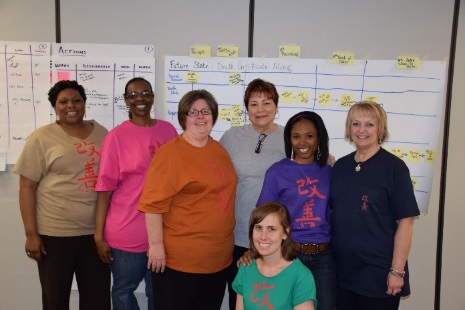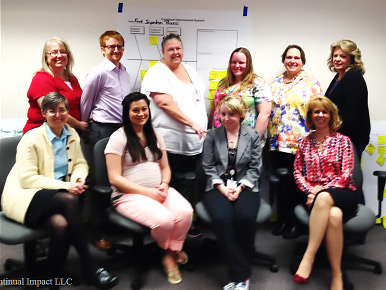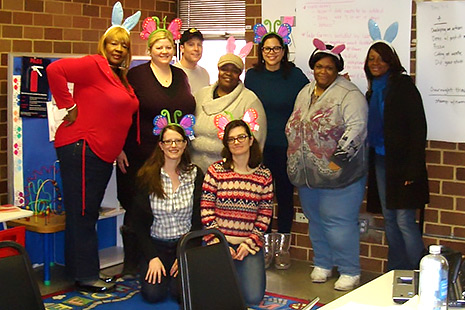Monday, September 29, 2014 - The heart, mind, soul, and muscle of your health department: your people!
Written by PHQIX Expert Panel member Chris Bujak and his business partner Pam Vecellio, of Continual Impact LLC. Visit the Ask an Expert page for more advice from PHQIX Expert Panelists.
The COPPHI Kaizen Event Program recently completed foundational QI and Kaizen training, coaching, and co-application of kaizen events at 10 health departments. The program was funded by the Robert Wood Johnson Foundation (RWJF), and managed by National Network of Public Health Institutes (NNPHI), with the training and expertise provided by Continual Impact LLC. Keys to successful Kaizen events and to creating a culture of high performance are the involvement, knowledge, actions and ownership of the individuals performing the work process. A Kaizen event helps to unlock the capacity of the people in your organization!
Kaizen simply means “change for the better”. A kaizen event is a team-based approach that enables improvement to be made by stepping through all phases of the improvement cycle in an effective and rapid fashion. Before the event, a kaizen-appropriate problem is identified along with goals in areas such as customer satisfaction, cycle time and labor reduction, and error elimination. The team is then mobilized and a kaizen event begins. A typical event uses a systematic process to identify waste in the targeted work process, enable the team to understand and analyze the root causes, identify and test solutions, learn, install improvements, and create a system for ongoing improvement. As the event progresses, numerous QI and change management methods and techniques are applied. The event enables the team to accomplish all this work quickly, typically in 5 days with full benefits achieved within 1-3 months!
 DeKalb County Board of Health’s kaizen event improved the labor time and accuracy of filing death certificate registrations. The team looked critically at the waste in their work process and the root causes, and then identified solutions such as: redesigning and mistake-proofing information request forms, creating standardized work for the funeral directors, defining and standardizing the acceptance criteria, defining team roles, eliminating redundant tasks, moving office space and equipment to facilitate the process flow, implementing scanning hardware/software, and redesigning the phone messaging prompts and the phone routing/rollover system. As a result, cycle time and labor content were reduced by more than 50%. All of this work was identified and executed in rapid fashion by the most valuable resource in any improvement activity--the Team!
DeKalb County Board of Health’s kaizen event improved the labor time and accuracy of filing death certificate registrations. The team looked critically at the waste in their work process and the root causes, and then identified solutions such as: redesigning and mistake-proofing information request forms, creating standardized work for the funeral directors, defining and standardizing the acceptance criteria, defining team roles, eliminating redundant tasks, moving office space and equipment to facilitate the process flow, implementing scanning hardware/software, and redesigning the phone messaging prompts and the phone routing/rollover system. As a result, cycle time and labor content were reduced by more than 50%. All of this work was identified and executed in rapid fashion by the most valuable resource in any improvement activity--the Team!
…and what did the team members have to say about the experience?
“Going from current to future state blew my mind – you have to experience it.”
“It is nice to see how proud people are and how they own these improvements and new process.”
“This kaizen event was a roller coaster—after I got off, I’m ready to do it again!”
“We dealt with a lot of personalities; emotionally trying but very successful.”
One particular team commented on their progress:
From: “We’ve never been asked our opinion before, we’re just told what to do,” “I have much more capability than people realize but feel looked down on because I’m just an operator,” “you’re just trying to get us to do more work,” “we expect when all this is done you will tell us we don’t have a job”.
To: “ In the end we got hugs from everyone, and they made comments like it turned out right like you told us on Monday,” “Sorry I was mean to you,” and “We’re sorry you are leaving.” “We ended up receiving positive feedback from everyone. Of course in 1 week it did not eliminate issues completely, but it was a powerful example of kaizen’s ability to generate positive energy in people!”
Other organizations with compelling “Team stories” during their Kaizen events can be found below:
 Kaizen events lend themselves to rapid improvements in routine health department processes. Tazewell County Health Department utilized Kaizen tools to full advantage--reducing administrative time related to food establishment inspections dramatically, exceeding the project aim. In the first month, they achieved an 80% reduction in both time and materials.
Kaizen events lend themselves to rapid improvements in routine health department processes. Tazewell County Health Department utilized Kaizen tools to full advantage--reducing administrative time related to food establishment inspections dramatically, exceeding the project aim. In the first month, they achieved an 80% reduction in both time and materials.
Untreated chlamydia (CT) and gonorrhea (GC) can lead to serious health problems in men and women. In order to effectively track and treat these two sexually transmitted infections, CDC guidelines require that low-priority CT and GC reports be processed by health departments within 30 days of receiving a reporting form from a laboratory or medical provider office. The Chicago health department had been experiencing a large backlog of these reports, and used a kaizen event and PDCA approach to dramatically reduce the processing and backlog time in order to improve the surveillance and control of these infections.  The staff was able to reduce the backlog time of low-priority CT and GC reports, receipt to closure in INEDSS, from 86 days to 30 days and anticipate further improvement. he STI Surveillance Program immediately changed the method for how incoming reports were sorted and bundled for assignment to data entry staff; developed a revised morbidity reporting form and standardized laboratory reporting form to reduce data entry time; and determined that data entry staff was keeping up with incoming reports and the backlog was perpetuated year after year and proposed a solution to management so that the backlog could be permanently addressed. Additional outcome was improved staff morale!
The staff was able to reduce the backlog time of low-priority CT and GC reports, receipt to closure in INEDSS, from 86 days to 30 days and anticipate further improvement. he STI Surveillance Program immediately changed the method for how incoming reports were sorted and bundled for assignment to data entry staff; developed a revised morbidity reporting form and standardized laboratory reporting form to reduce data entry time; and determined that data entry staff was keeping up with incoming reports and the backlog was perpetuated year after year and proposed a solution to management so that the backlog could be permanently addressed. Additional outcome was improved staff morale!